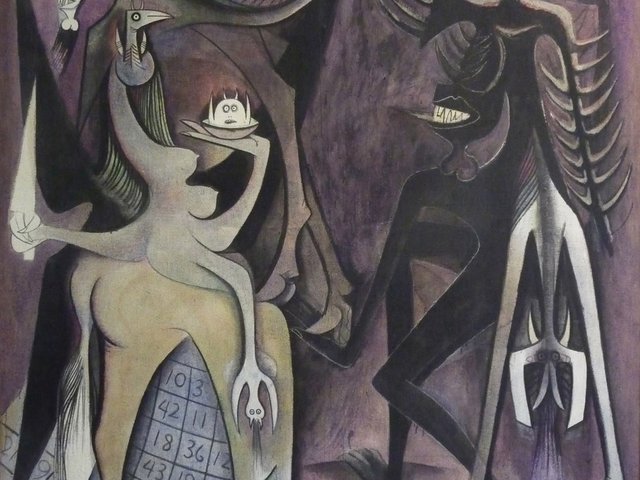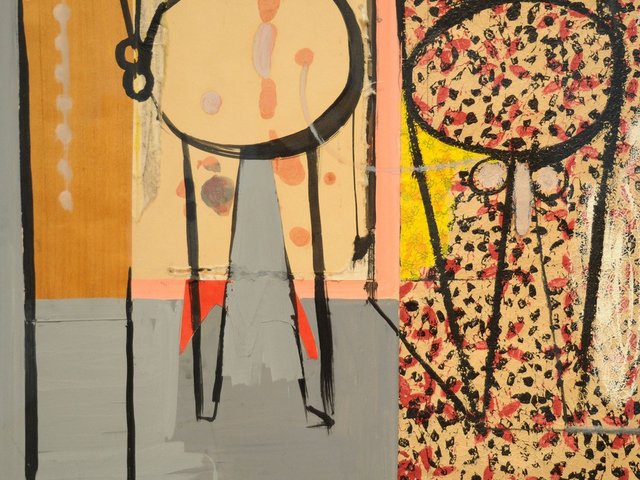A number of exhibitions and publications marked the centenary of Denmark’s most celebrated artist, Asger Jorn (1914-1973). Jorn was a complex artist whose output exists in at least ten different media; that is even before one considers his political, philosophical, architectural and ethnographic activities.
Communist roots
Jorn joined the Communist Party in Denmark when he was about 16. He later completed his education in Paris under Fernand Léger and Le Corbusier. After the Second World War, which he spent in Denmark assisting the resistance, he cofounded the Cobra avant-garde movement. In 1957, seeking to emphasise the political dimension to his activities, Jorn became a prominent member of the Situationist International group.
Jorn published short texts and books, theorising on topics ranging from the artistic to the political and philosophical. The urgent question for socially minded artists in the immediate post-war period was how to operate in the Cold War; should they assimilate or oppose the domination of Western European Modernism? Jorn suggested that two Modernist strands could co-exist: the mainstream derived from French art and Mediterranean cultures and another, assertively Nordic in culture and form.
Jorn began an ambitious project called 10,000 Years of Nordic Folk Art, intended to document Scandinavian visual culture, inspire Northern artists and rehabilitate Nordic imagery following Nazi co-option. Although Jorn sought to assert a Nordic alternative to mainstream Modernism, he was at the same time critical of modern Denmark’s culture of moderation and conformity. Jorn’s lifetime body of inventive, sardonic and aggressive work is a harsh and eloquent damnation of cautious Danish art.
In Restless Rebel, Jorn’s art is examined where it most apparently intersects with group activity and political and artistic theory. Essay readings are not specifically biographical and authors interpret with the assistance of cultural context. Overall it presents the highlights of Jorn’s career.
Meanwhile, Jorn’s printmaking is highlighted in the volume Asger Jorn in Images, Words, and Forms, by Ruth Baumeister. Jorn’s late woodcuts, influenced by his travels to Japan and the example of Munch, are striking but remain little known. Baumeister provides a brief survey of the many aspects of Jorn’s art and her title is perhaps the better introduction to Jorn’s output.
Detailed analysis
The Art and Politics of Asger Jorn, by Karen Kurczynski, provides a detailed analysis of Jorn’s theory and his negotiation of the fractured landscape of the post-war avant-garde. Kurczynski describes Jorn’s commitment to communal art activities as partly inspired by his Communist background and the experience of communal resistance during the Nazi occupation of his homeland. Not only was Jorn affiliated to art groups, he also worked collaboratively in many fields.
Jorn’s thought and art was a constant negotiation between the poles of high and low art, fine and everyday materials and political positions that he could not endorse. These publications conclusively demonstrate that Jorn cannot be considered as essentially a painter but as an artist who operated in many different media. His refusal to make desirable commodities was an expression of his core ideas. Although the paintings can be appreciated in isolation, the artist himself must be understood in all his complex, contradictory totality.
Asger Jorn in Images, Words, and Forms
Ruth Baumeister
Scheidegger & Spiess, 144pp, €38 (pb)
The Art and Politics of Asger Jorn: the Avant-Garde Won’t Give Up
Karen Kurczynski
Ashgate, 292pp, £65 (hb)
Asger Jorn: Restless Rebel
Ed. Statens Museum for Kunst
Prestel/SMK, 280pp, £35, $49.95 (hb)
Alexander Adams is a British writer and art critic. His most recent book of poems and drawings, The Crows of Berlin, was published last year by Pig Ear Press.



